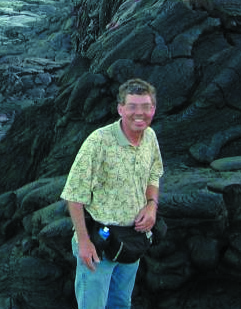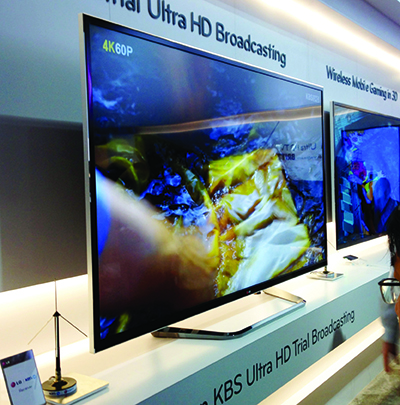
DOUG LUNG Twenty years ago broadcasters filled a 6 MHz channel with one analog color TV video signal that hardly matched the quality of today’s standard-definition digital TV pictures. Now broadcasters are transmitting a highdefinition signal and often one or more standard-definition TV signals and even a robust stream for mobile/handheld reception in the same 6 MHz channel.
At the Samsung booth at the CES International last month I saw a Korean Broadcasting System demonstration of 4K UHDTV transmitted over a 6 MHz channel using DVB-T2. Improved video compression techniques—MPEG-2, then H.264 and now HEVC—allow higher resolution at lower bit rates. Efficiently delivering these bits overthe- air requires digital coding to allow accurate recovery of the data stream in the presence of noise and interference.
REVIEW OF DIGITAL CODES
ATSC broadcasting uses Reed- Solomon coding and trellis coding to allow the 19.39 Mbps data stream to be received with a predicted signal-to-noise (SNR) threshold as low as 15 dB SNR in a 6 MHz channel. ATSC A/153 mobile DTV adds turbo codes to drop the required SNR to as low as 4 dB, but at a much lower data rate. I explain how this works in my article “Error Correction in ATSC Mobile DTV” (RF Technology, Nov. 3, 2010).
Since the ATSC standards were adopted, more powerful coding methods such as Low Density Parity Check (LDPC) and Bose-Chaudhuri Hocquenghem (BCH) have replaced Reed-Solomon coding and turbo codes as the preferred coding method for digital transmission. LDPC and BCH are used in the DVB-S2 and DVB-T2 standards.
Coding techniques can be compared by seeing how closely their performance approaches the Shannon limit. Fig. 1 is the cropped lower-right portion of the chart in Annex C of the ATSC Final Report on ATSC 3.0 (www.atsc.org). It compares the spectral efficiency of existing and proposed DTV transmission standards in comparison with the Shannon limit.
Fig. 1: Spectral efficiency of existing and proposed DTV transmission schemes. From “Final Report on ATSC 3.0 Next Generation Broadcast Television,” ATSC Planning Team 2, Advanced Television Systems Committee
THE SHANNON LIMIT
The Shannon limit is named after its inventor, Claude Elwood Shannon, the mathematician who has been called “the father of information theory.” In 1948 he published the paper “A Mathematical Theory of Communications.” The paper showed how to calculate the maximum error-free data rate for a channel given its bandwidth and noise characteristics. Shannon called it “channel capacity,” but people soon began calling it the “Shannon limit.” It can be calculated using the formula:


Where W is the bandwidth in hertz, S is the average received signal power in watts, and N is the average noise power.
The professional video industry's #1 source for news, trends and product and tech information. Sign up below.
The solid blue line in Fig. 1 is the Shannon limit. The X axis is the carrier-to-noise ratio and the Y axis is the spectral efficiency in bits/second/hertz. You will notice that the green line is the one closest to the Shannon limit. This is DVB-T2, with QPSK, 16-QAM and 64-QAM modulation (left to right). 256-QAM is to the right in the full chart. DVB-T2, as noted, uses LDPC and BCH coding. The orange line represents LTE. The thin blue line with stars is A/53 VSB, but with LDPC coding. Notice how well it performs. The short red line is full channel A/153 mobile DTV, which uses turbo codes.
While it appears to be slightly better than DVB-T2 LDPC coding at a 5 dB C/N, the maximum data rate is extremely limited and it is questionable whether this performance is achievable with A/153 under real- world conditions. Note that all of these curves show predicted performance under AWGN (Additive white Gaussian noise) conditions.
INTRODUCTION TO LPDC CODES
The comparison chart shows the superior performance of LDPC. LDPC codes were first proposed by Robert G. Gallager in his 1960 doctoral dissertation in the Department of Electrical Engineering at M.I.T. He expanded and revised the work in his 1963 paper “Low Density Parity Codes.” However, the codes did not see practical use until after the introduction of turbo code in the mid 1990s.
The history of turbo codes is interesting. When Berrou and Glavieux presented turbo codes with simulation curves showing performance very close to the Shannon limit at the IEEE International Conference on Communications, many experts at the conference laughed at the claims and either did not attend the presentation or said the simulations were in error. Berrou and Glavieux, after all, were not mathematicians.
In his paper “Turbo Codes: Some Simple Ideas for Efficient Communications” Berrou writes, “The invention of turbo codes did not result from a linear limpid mathematical demonstration. It was the outcome of an empirical construction of a global coding/ decoding scheme, using existing bricks that had never been put together in this way before.”
Professor McEliece later said, “What blew everyone away about turbo codes is not just that they get so close to Shannon capacity, but that they’re so easy. How could we have overlooked them? Berrou and Glavieux didn’t know the problem was supposed to be hard, so they managed to find a new way to go about it.” (from Prof. Angel Lozano’s “Hall of Innovation” at www.dtic.upf.edu/~alozano/innovation/)

At the Samsung booth at the International CES last month, the Korean Broadcasting System demonstrated 4K UHDTV transmitted over a 6 MHz channel using DVB-T2. LDPC codes, which share some of the features of turbo codes, including iterative and soft decision characteristics, were rediscovered by two researchers, David MacKay and Radford Neal, in the mid- 1990s, who later realized these were the same LDPC codes discovered by Gallager in the 1960s. Indeed, on closer inspection the algorithm used to decode turbo codes turned out to be a special case of the decoding algorithm for LDPC codes presented by Gallager.
Today, the mathematicians appear to have won. LDPC codes, unlike turbo codes, have a decoding algorithm consisting of simple operations such as addition, comparison and table lookup. They can be parallelized in ways that make it easy to trade off throughput for complexity. Other researchers continued work on LDPC and produced new irregular codes that outperformed the best turbo codes. Indeed, given sufficient processing capability, it is now possible to produce LDPC codes that approach the Shannon limit within a few hundredths of a decibel!
After researching this article I’m beginning to believe that improvements in radio communication are going to depend as much on improved coding before modulation/ after demodulation as new RF transmission technology.
In future columns I’ll show how LDPC codes work (with as little math as possible) and show how they are used in today’s DVB-T2 and DVB-NGH standards.
Comments and questions are welcome! Email me atdlung@transmitter.com.

Doug Lung is one of America's foremost authorities on broadcast RF technology. As vice president of Broadcast Technology for NBCUniversal Local, H. Douglas Lung leads NBC and Telemundo-owned stations’ RF and transmission affairs, including microwave, radars, satellite uplinks, and FCC technical filings. Beginning his career in 1976 at KSCI in Los Angeles, Lung has nearly 50 years of experience in broadcast television engineering. Beginning in 1985, he led the engineering department for what was to become the Telemundo network and station group, assisting in the design, construction and installation of the company’s broadcast and cable facilities. Other projects include work on the launch of Hawaii’s first UHF TV station, the rollout and testing of the ATSC mobile-handheld standard, and software development related to the incentive auction TV spectrum repack. A longtime columnist for TV Technology, Doug is also a regular contributor to IEEE Broadcast Technology. He is the recipient of the 2023 NAB Television Engineering Award. He also received a Tech Leadership Award from TV Tech publisher Future plc in 2021 and is a member of the IEEE Broadcast Technology Society and the Society of Broadcast Engineers.
